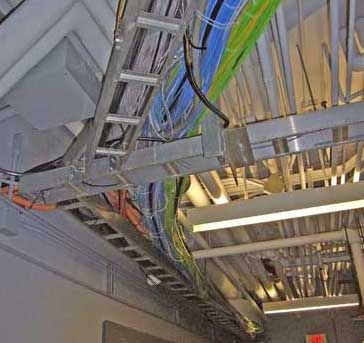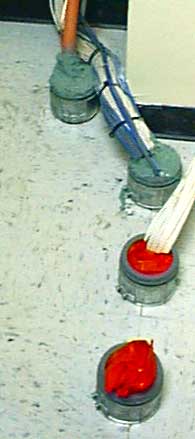Premises
Site Preparation For Fiber Optics
Before
beginning installation of fiber optic cables and
hardware in a premises
installation, the site must be properly prepared for
the installation
of fiber optic cables, hardware and transmission
equipment.
Premises Support Structures
There
are numerous structures used for the securing of fiber
optic cable in
premises installations making generalizations
difficult. Cable may be
hung on appropriate hangers, laid in trays or pulled
in conduit or
innerduct.

Install support structures for
fiber optic cable
installations before the installation of the fiber
optic cable itself.
These structures should follow the guidelines of
TIA/EIA 569-A and
NECA/BICSI 568-2001. Allow for future growth in
the quantity and
size of cables when determining the size of the
pathway. Follow all
cable bend radius requirements.
Do not install a fiber optic cable
in a conduit or duct that already contains cabling,
regardless of the
cable type. Existing or new empty ductwork can
be modified to
accept several different installations by the
placement of innerduct
within it.
Removal of Abandoned Cables
Unless
directed by the owner or other agency that unused
cables are reserved
for future use, remove abandoned optical fiber cable
(cable that is not
terminated at equipment other than a connector and not
identified for
future use with a tag) as required by the National
Electrical Code or
other local codes. At the discretion of the owner of
the site, the
contractor may be requested to remove other cables
(e.g. copper
communications or power cables) in addition.
Removal of cables is
much more time consuming than installation, as each
cable must be
identified and carefully removed to prevent damaging
other cables. No
cable should be cut for removal unless it is
positively identified as
one to be removed.
All removed cables should be
recycled properly
as most cable has significant scrap value, not only
for any copper
conductors but for other metallic elements and even
plastics.
Fire Stopping
All
premises cabling requires firestopping at all
penetrations.
Telecommunications firestopping shall comply with
applicable codes and
standards, including TIA/EIA 569-A-Annex A and
NECA/BICSI 568-2001.

All
penetrations shall be protected by type-approved
firestops. Fire
stopping compounds and devices shall be used whenever
a fire separation
has been breached by an installation.
In most geographical
locals the breaching of a fire separation will require
physical
monitoring until it has been repaired.
Check with the “Authority Having Jurisdiction” for
specific
requirements on the project before commencing work.
Electrical Systems
All
fiber optic equipment will require proper power at the
locations of the
equipment. Power must be high quality power, protected
for surges and
splikes, and generally must have appropriate backup
capacity to prevent
loss of communications during power loss. Consult with
the site owner
and appropriate electrical contractors to plan
electrical power
installation.
Grounding and Bonding
All conductive
cabling and components must be grounded and bonded.
Ground systems
shall be designed as specified by the NEC or other
applicable codes and
standards (ANSI/TIA/EIA 607-A,
NECA-BICSI-568-2001).
Although
most fiber optic cables are not conductive, any
metallic hardware used
in fiber optic cabling systems (such as wall-mounted
termination boxes,
racks, and patch panels) must be grounded.
Conductive cables require proper
grounding and bonding for applicable conductors.
Marking
Fiber optic cables should be
specified with colored jackets per industry
standards
which indentify the cables as fiber optic cables and
indicate the type
of fiber in the cable. All fiber optic
cables should be
marked at each end with identification numbers that
will indicate on
documentation where the cables terminate. Fibers
withing the cables
should be identified by color codes also. Cables
should be tagged with
identification that they are fiber cables and proper
handling is
required.
More Topics
On Fiber Optic Installation
|
